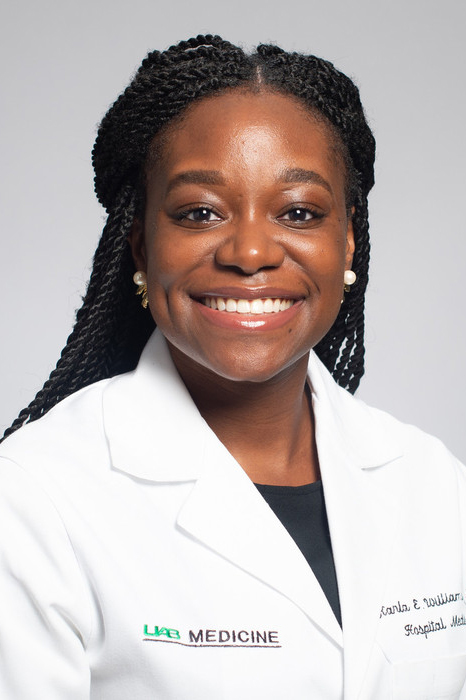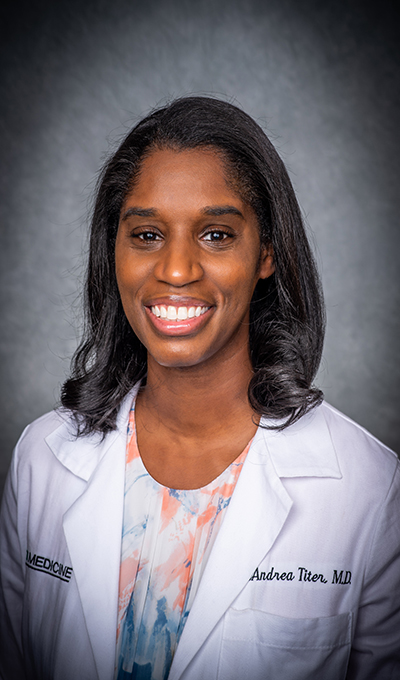In the final part of Heersink School of Medicine Office for Diversity and Inclusion’s Black History Month series, we’ll take a look at how two general internal medicine doctors improve occupational wellness for future generations of physicians.
To many, the idea of occupational wellness is learning to balance work and life. But to KeAndrea Titer, M.D., assistant professor in the Division of General Internal Medicine and Karla Williams, M.D., assistant professor in the Division of General Internal Medicine and director of Diversity and Inclusion in the Tinsley Harrison Internal Medicine Residency Program, occupational wellness also includes having satisfaction in one’s career. Karla Williams, M.D.
Karla Williams, M.D.
During their internal medicine residency at UAB, Titer and Williams collaborated to create a community that supported one another. In 2017, the doctors along with their colleagues started creating a curriculum that addressed how the medical community could support trainees experiencing macro- and micro-aggressions from patients.
“For me, occupational wellness means that you find fulfillment in your job, add value to the people that you’re serving, feel like you’re a part of a community that supports one another, and have the opportunity to grow,” Titer explained. “If those four things align, you have optimal occupational health.”
Since then, Titer and Williams have presented the curriculum at venues throughout UAB as well as other academic institutions. Additionally, they have earned grant funding for, “Closing the Divide: Building Trust by Addressing Bias in Medicine.” This initiative will allow them to build on their existing training and expand into an online format, free of cost to participants.
The Office for Diversity and Inclusion sat down with Titer and Williams for a Q&A to share the program’s impact and how building the curriculum can be translated into occupational wellness across departments and job titles.
What started your involvement in diversity recruitment efforts?
Titer: I know our students have incredible perseverance and dedication. They will overcome whatever obstacle comes their way; however, that path could also be smoother and more manageable if there is someone along the way to help them. Some people did that for me, and I want to give back in the same way.
Williams: The catalyst for me was being an African-American female entering the field of medicine. I understood the challenges of having that identity and being in medicine—the hurdles that you have to overcome to get into medical school and be successful. Then, there’s getting into residency and the challenges that could come up when interacting with patients.
I’ve been in the diversity, equity, and inclusion realm since undergraduate school, so it was a continuation of the work that I’d already done. However, after going through medical school, I realized how important it was for me to reach back and help the next generation. I could provide mentorship to make that path more accessible and transparent by providing better guidance.
Were microaggressions in patients something you were taught in school?
Williams: No, it actually wasn’t something that was introduced in school. The idea to create this curriculum came from our program leadership during my chief year. Seeing the residents’ reports of experiencing macro- and micro-aggressive behaviors sparked conversations throughout our very responsive residency program. Our program directors were concerned about seeing these reports and determined that creating a curriculum that taught residents and faculty how to respond to these situations and support one another during these encounters was a necessity.
How does the curriculum train residents to respond to macro-and micro-aggressive behaviors?
 KeAndrea Titer, M.D.Titer: Essentially, the curriculum is based on a four-step process that we call ‘Clearing the AIRR.’ The A stands for assessing the situation; the I is to identify the behavior; the first R represents responding to the behavior; and the final R stands for reporting the action. Reporting avenues for these behaviors is important because it shows the response and ensures things are documented.
KeAndrea Titer, M.D.Titer: Essentially, the curriculum is based on a four-step process that we call ‘Clearing the AIRR.’ The A stands for assessing the situation; the I is to identify the behavior; the first R represents responding to the behavior; and the final R stands for reporting the action. Reporting avenues for these behaviors is important because it shows the response and ensures things are documented.
Williams: With formal documentation, we can leave notes on a patient’s electronic medical record through what’s called a ‘disruptive patient power plan.’ These notes include the type of behavior displayed and a narrative by the person who experienced it. The Trend Tracker system is another way to document behavior that has helped track certain patients with repeated encounters. In that process, information put into the system is used to develop a plan for those who care for the patient—how care is delivered, how to maintain safety, etc.
For those that aren’t in a clinical space, how can they use this framework to create occupational wellness in their careers?
Williams: This program can improve occupational wellness because it brings to light what appears to be invisible, macro- and micro- aggressive behaviors in the work setting, clinical and nonclinical environments. Many times, aggressive or inappropriate behaviors may seem to be a reality only to those subjected to it. Now, we are lifting the veil and showing what goes on, how macro- and micro-aggressive behaviors look, how they are defined, how they impact each individual and their work, and how to respond. Proper training bridges the gap—it creates new relationships, creates an opportunity for people to better understand one another, fosters a greater sense of belonging and community, and increases fulfillment and job satisfaction.
Being valued and able to express the totality of who you are, without fear or reservation, definitely contributes to wellness.